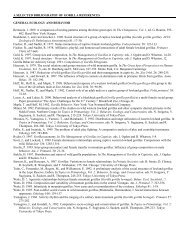First Prosimian Husbandry Workshop 2009 - Cleveland Metroparks ...
First Prosimian Husbandry Workshop 2009 - Cleveland Metroparks ...
First Prosimian Husbandry Workshop 2009 - Cleveland Metroparks ...
Create successful ePaper yourself
Turn your PDF publications into a flip-book with our unique Google optimized e-Paper software.
Session 10: <strong>Prosimian</strong> Training:<br />
(Moderator Megan Elder, St. Paul’s Como Zoo)<br />
Topics<br />
Basics of training (how it works, benefits, setting up a program)<br />
Examples (basics thru advanced)<br />
1. Describe voluntary physicals at Indianapolis<br />
2. Buffalo Zoo will describe success with insulin injections<br />
3. Busch Gardens will discuss depo injections.<br />
Problem solving (ask audience what issues they have), Q & A, misc applications- if time allows<br />
(public demos, painting etc)<br />
Close, provide resources & contact information<br />
Basic Concepts<br />
<strong>Husbandry</strong> training is a program that incorporates the concepts of operant conditioning in daily<br />
management routines. Antecedent leads to a behavior which is bridged and then a consequence<br />
happens. We are discussing positive reinforcement by rewarding behavior you want and ignoring<br />
unwanted behavior. See CD for references.<br />
One of the first steps is determining what is reinforcing for your animal.<br />
Question (Kathleen Milk): Does anyone use secondary reinforcement?<br />
Response: Tactile contact or access to space can serve as a reinforcer.<br />
Next you need to introduce your bridge which marks the bridge. You need to come up with shaping<br />
plans where you make small approximations of behavior. It is important to have both a visual/verbal<br />
cue. When you are starting out, you need to have primary and secondary trainers. One person trains<br />
the behavior first and then other keepers can then begin to learn that behavior.<br />
Question: What about having one animal with different trainers training different behaviors?<br />
Response (Jacqueline Broder): If the bridge is consistent, this should not be an issue.<br />
Response: It is important to watch each other train.<br />
Comment (Kris Becker): You can videotape the behavior as well.<br />
Comment (Julie Taylor): We don’t have more than one keeper training a behavior at a time.<br />
Comment (Jennifer Donovan): Make sure trainers are communicating so behaviors don’t break down.<br />
Moderator (Megan Elder): Creating a training manual is very important and including pictures of<br />
trained behaviors.<br />
The final step is to execute, evaluate and modify your plan. It is extremely important to set up animals<br />
to succeed and to end on a positive note.<br />
Some basic behaviors being trained:<br />
Stationing-this helps reduce competition.<br />
Question (Ingrid Porton):- What is the difference between the targets?<br />
Moderator (Megan Elder): Usually the targets are different shapes and colors.<br />
Comment (Dan McLaughlin): We started with locations and then moved to shape/color.<br />
Comment (Laura Suski): It is important that you let them choose their positions and then let them<br />
decide where they are comfortable.<br />
47




